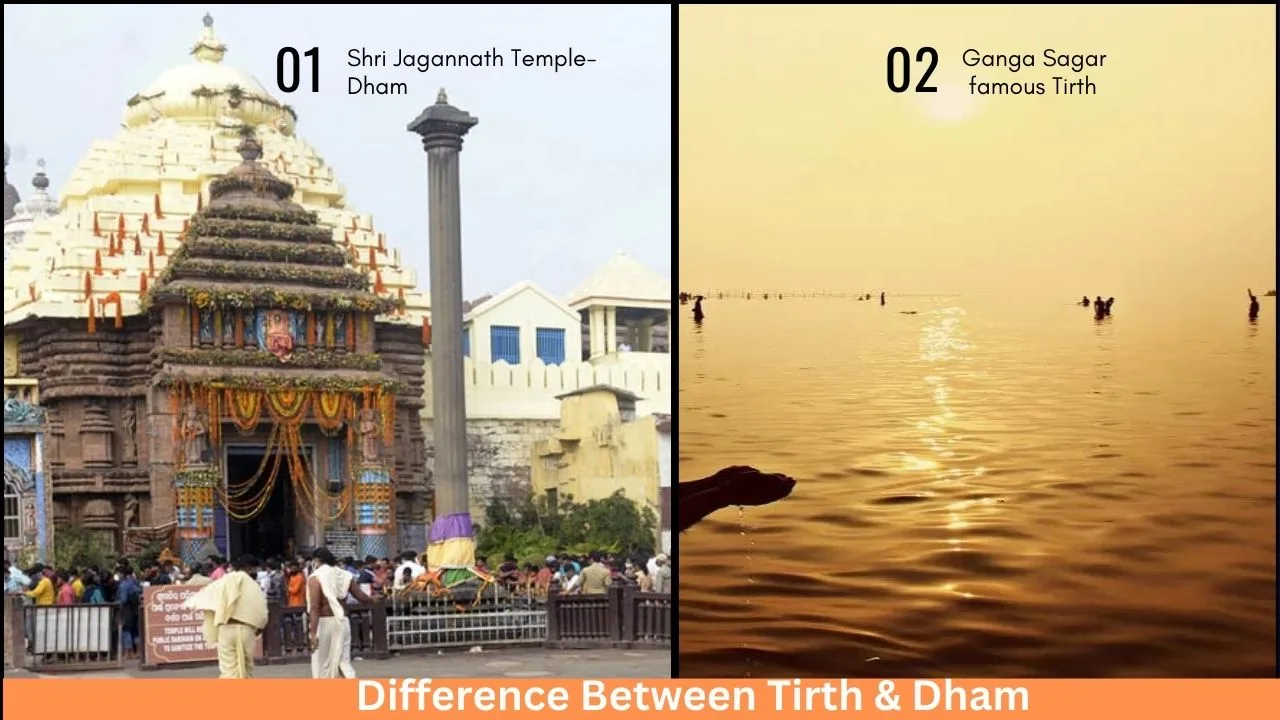Many peoples thinks that there is no difference Between Tirth and Dham, but actually both the things are different and can be explained. India, often called the land of spirituality, is dotted with numerous sacred places that draw pilgrims and devotees from all corners of the world. Among these, the terms “Dham” and “Teerth” hold special significance in Hinduism.
While they both refer to places of religious importance, they have distinct meanings and roles within the framework of Hindu religious practices. In this article, we’ll delve into the difference between teerth and Dham, shedding light on their unique attributes and cultural importance.
Dham: Where Spirituality Meets Mythology
What is Dham in Hinduism
“Dham” is a term deeply rooted in Hindu mythology and tradition. It refers to a sacred pilgrimage site or a place of religious significance, often associated with specific deities or events from Hindu scriptures and legends. Dhams are considered divine abodes where the spiritual and the mythological converge.
Spiritual significance of Dham in Hinduism
Dhams are primarily centers of religious worship and devotion. Pilgrims embark on journeys to these revered sites to seek blessings, offer prayers, and perform rituals. The act of visiting a Dham is believed to facilitate spiritual growth and bring one closer to the divine.
The Char Dham Yatra
One of the most famous and sacred pilgrimages in Hinduism is the Char Dham Yatra, which includes four major Dhams
- Badrinath: Located in the state of Uttarakhand, Badrinath is dedicated to Lord Vishnu.
- Dwarka: Situated in Gujarat, Dwarka is associated with Lord Krishna.
- Puri: In the eastern state of Odisha, Puri is dedicated to Lord Jagannath.
- Rameswaram: Found in Tamil Nadu, Rameswaram is revered as the place where Lord Rama built a bridge to Lanka.
These four Dhams are considered the most sacred and significant pilgrimage sites in Hinduism, attracting millions of devotees each year.
Other Famous Dhams
While the Char Dham holds immense importance, India is replete with other Dhams, each with its own historical, religious, and mythological significance. These Dhams may be dedicated to various deities, saints, or revered figures from Hinduism.
For More information on Dham in India – Read Teerth Yatra in India
Tirth: The Purifying Waters of Devotion
What is a Tirth in Hinduism
“Tirth” is another term integral to Hinduism, but its focus differs from that of Dham. Teerth refers to a holy place, Mountain, River, Lake or any water source, Lake, Pond Sarovar, where any Saint or Deity has attained Gayana or Moksha. Hindus traditionally perform ritualistic baths and offer prayers at these places and believed to possess spiritual and purifying qualities.
Spiritual Purification
Bathing in a Teerth is considered an act of cleansing and spiritual purification. Devotees believe that by immersing themselves in these sacred waters, they can wash away their sins and impurities, thereby gaining spiritual merit.
Revered Tirths
India boasts numerous revered Teerths, and some of the most prominent ones include:
The Ganges (Ganga) River: Widely regarded as the holiest of all rivers, the Ganges is believed to have the power to cleanse one’s soul.
The Yamuna River: Associated with Lord Krishna, the Yamuna holds immense significance for devotees.
The Godavari River: Located in southern India, the Godavari is considered a sacred Teerth.
Prayag (Allahabad): The confluence of three rivers—Ganges, Yamuna, and the mythical Saraswati—is known as Prayag, a site of immense spiritual importance.
Teerths in Religious Festivals
Teerths play a central role in many Hindu festivals and gatherings. The Kumbh Mela, one of the largest religious gatherings on Earth, is a prime example. Millions of pilgrims gather at the confluence of Teerths during the Kumbh Mela to partake in rituals and seek spiritual blessings.
The Interplay of Dham and Teerth
While Dhams and Teerths serve different purposes within Hinduism, there is often an interplay between the two. Many Dhams are located in close proximity to Teerths, allowing pilgrims to combine both spiritual experiences during their visits.
For instance, the Badrinath Dham is situated near the Alaknanda River, which is considered a Teerth. Pilgrims visiting Badrinath often take a holy dip in the Alaknanda River to purify themselves before entering the temple.
Similarly, the city of Varanasi (also known as Kashi), one of the oldest inhabited cities in the world and a prominent Dham, is located on the banks of the Ganges River, a revered Teerth. Devotees visiting Varanasi not only seek blessings at its temples but also perform rituals and take dips in the Ganges to attain spiritual purity.
Conclusion of Difference between Tirth and Dham
In the tapestry of Hinduism, Dhams and Teerths are threads that weave together the spiritual, mythological, and cultural fabric of India. Dhams are the destinations where devotees express their devotion and reverence, while Teerths are the sources of purification and spiritual renewal.
Whether one embarks on a journey to the sacred Badrinath Dham nestled in the Himalayas or takes a dip in the holy waters of the Ganges, the ultimate goal remains the same: to seek a connection with the divine, cleanse the soul, and find spiritual solace in the embrace of India’s sacred landscapes. The distinctions between Dham and Teerth are bridges to a deeper understanding of the multifaceted tapestry of Hindu spirituality and tradition.


Tirth and dham are fundamental concepts in Hindu spirituality. Tirths are pilgrimage sites, often near rivers or mountains, where devotees seek purification and blessings. Dhams are divine abodes, like Badrinath and Dwarka, where worshipers connect with deities. These sacred places are central to Hindu faith, fostering devotion and cultural heritage.
I had confusion between tirth and dhams. I knew about chardham yatra but was not sure about it. Now by reading this article I have cleared my confusion about the topic.
Great to hear that we have been able to clarify your confusion regarding Tirth and Dham.
Is Amarnath a Dham or Tirth? Why?
ok
Amarnath is considered as Dham.